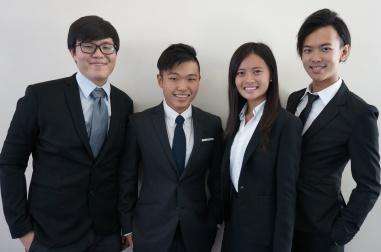
These NUS students boldly suggest removal of Malaysian Airlines' CEO to survive
That's just one part of the strategy.
Malaysian Airlines CEO Ahmad Jauhari Yahya is certainly not short on advice about what to do to recover from the twin tragedies of MH370 and MH17. We've already heard opinions from the 'adults' -from marketing executives to the world's aviation industry experts. While their suggestions might work, one way or another, perhaps hearing from the kids this time will turn into something worthwhile.
NUS Bachelor of Business Administration (BBA) students consisting the Team Uni Consulting had the following suggestion for MAS to boost revenues and cut costs, which won them first place in the recently concluded United Overseas Bank-National University of Singapore (UOB-NUS) Case Competition (national category). Besting 150 teams from different universities in the city, The proposal recommended a three-part strategy to mitigate the impact of the recent MAS disasters, cut costs and raise revenues. Noteworthy is the bold recommendation to replace the senior management to signal MAS's intention to address structural problems, thereby reassuring customers and controlling the damage to the brand.
| Silkair crashed, they survived. Airfrance crashed, they survived. In the face of the problem of whether MAS will survive, our recommendations are centred around the STAR strategy. STAR is a representative acronym of our main recommendations – Salvage, Target, Attract & Retain. These recommendations are in chronological order. In Salvage, we proposed a change of the top management, specifically the CEO and an enhancement of their current Enrich loyalty program. Firstly, we contend for a change in the CEO because MAS’s problems started due to mismanagement, long before the 2 disasters. Secondly, we want to focus on existing customers with positive experiences instead of engaging new customers. We can tap on their frequent flyer program, Enrich, and further reach out to existing customers by offering more flyer points and easier upgrades, building their loyalty and customer lifetime value. Furthermore, we intend to use both social media and traditional media with a campaign tagline ‘I fly MAS do you’ to put the safety association back into the MAS brand. Under Trim, our cost-cutting measures, we aim to operate just the ASEAN routes. At the same time, we would reduce our idle capacity (manpower and aircraft) through laying off and wet leasing measures in an effort to keep costs to a minimum. In addition, we suggest the replacement of its current aircrafts with more fuel efficient ones to save huge fuel costs in the long run. Lastly, in Attract and Retain, we would be capitalising on strategic relationships built with the Malaysia Tourism Promotion Board (MTPB), Malaysia Convention and Exhibition Bureau (MyCEB) and Meetings, Incentives, Conventions, Exhibitions (MICE) to secure future sustainable growth with these increasing sectors. Expansion of routes to Asia Pacific which has the highest market growth is also recommended as a long run strategy after MAS’s revenues have stabilised. With our STAR strategy, we aim to not just crash and survive but be that star in the ASEAN region and bring MAS soaring through the skies once again. |
The competition is now on its sixth. The NUS students consisting the Team Uni Consulting are Shawn Ng Jing Jie, Lee Po Xian, Kristel Tey Hui Shi and Joshia Kwa Jing Le.
In the international category meanwhile, The team consisting of Lenard Lou, Soh Hwa Jie, Low Li Ting and Mabelyn Tan, undergraduates from NUS Business School, emerged as the champion, with the University of Hong Kong taking the first runner-up position and University of California, Berkeley placed as second runner-up. They were also required to propose strategy for MAS.
The proposal from the NUS team included MAS leveraging on its strong government affiliation and one-word alliance partners, reduction of flight frequencies, and upholding high safety standards.
| After the recent announcement of Kazanah Nasional’s 12-point restructuring plan for Malaysia Airlines (MAS), our team wanted to further analyse ways in which we could provide recommendations that could augment the restructuring plan and accelerate MAS’ return to profitability. To do so, we analysed the situation that MAS finds itself in from a two-pronged approach of differing time frames. We looked at how MAS can raise its revenues and decrease its costs in the Short-Run and in the long run, how MAS can differentiate itself from other competitors in the full-service carrier segment of the market. In the short-run, we advocated that MAS should leverage on its strong government affiliations and national identity to appeal itself to business travellers of Malaysian Government-Linked Corporations (GLCs) through a tactical promotion campaign. This campaign essentially allows MAS to convert wary business travellers into loyal customers by demonstrating the ability of MAS to consistently deliver a premium offering that meets the needs of the business traveller. Looking at the cost side of the equation, we advocated that MAS reduces frequencies of the flight routes that are essentially below the break-even load factor. By doing so, MAS will then reduce its need for medium to long-haul aircraft. This in turn, would bring about the accelerated asset disposal of MAS’ ageing 777 fleet and streamline the airline’s operations. Doing so would allow MAS to reduce maintenance, depreciation and staff training costs. Further leveraging on one-world alliance partners like Qatar Airways was also recommended to ensure that MAS travellers do not lose connectivity to long-haul destinations after the rationalization of flight routes. In the long-run, we advocated that MAS should market itself based on an added aspect of safety. Upon analysis of the many airlines in the industry, we realized that few airlines pride themselves on being safe as a differentiating factor. This signifies that consumers have come to treat accord safety as an expected basic product level. However, with every aviation incident, the issue of safety is brought to the forefront once again. We identified an opportunity for MAS to capitalize on to differentiate itself based on upholding high safety standards and communicating this explicitly to the public through safety campaigns. Also, we advocated that MAS should also pioneer new improved safety regulations in the industry to garner good publicity for the airline. By doing so, MAS would hopefully be able to eradicate the negative perception that currently prevents many potential customers from flying with the airline. With the above recommendations augmenting Kazanah’s 12-point restructuring plan, we hope to see MAS’ return to profitability by end-2017. |
























 Advertise
Advertise








